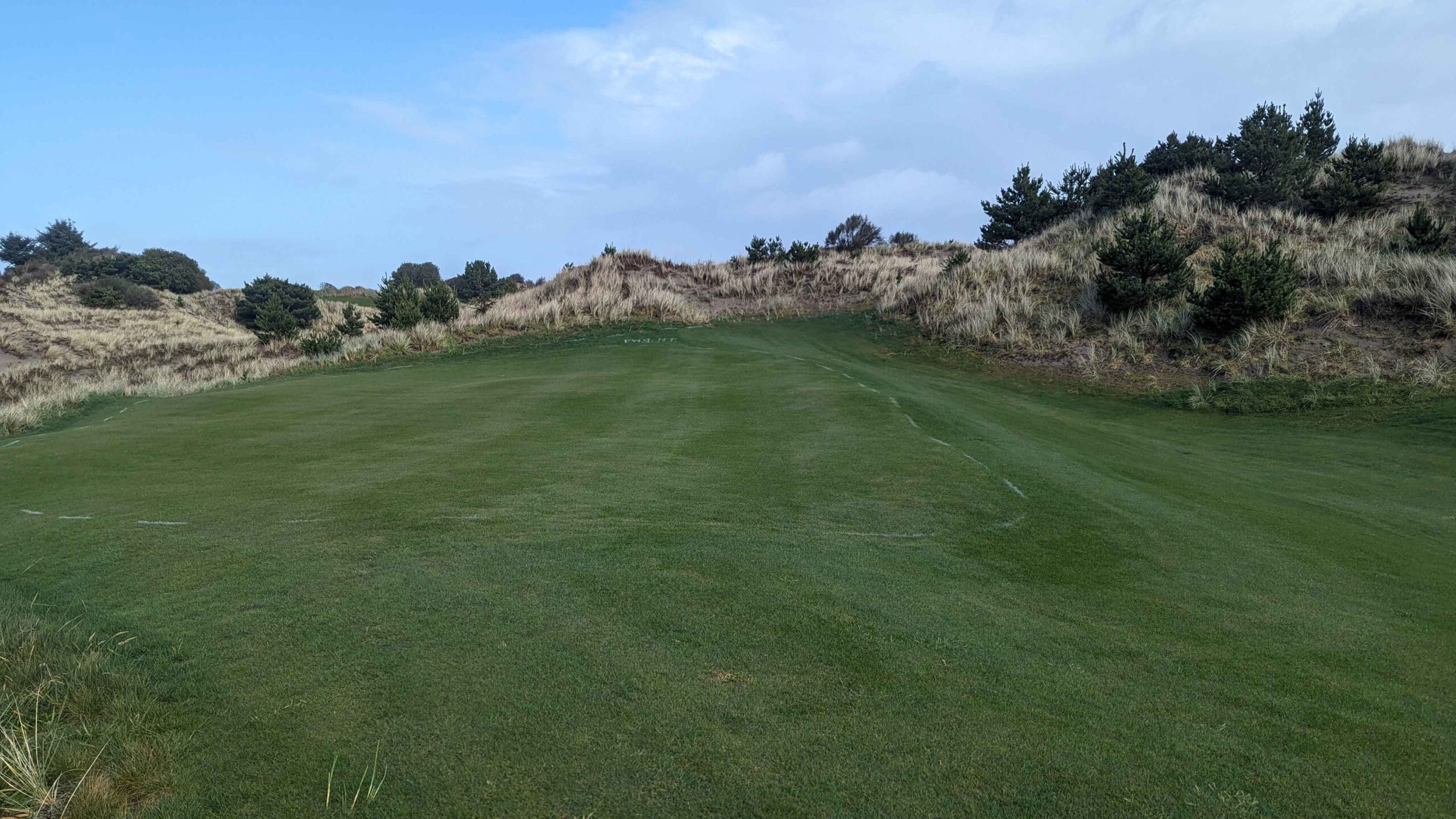Welcome back to Design Notebook, where we’re nominating Johnson Wagner as the heir to Ken Brown’s guy-on-an-empty-golf-course-segment throne. Get that charming, mustachioed man out there tossing basketballs around! Clearly he has an arm.
In today’s installment of DN, Garrett Morrison has a few takeaways from his recent visit to Shorty’s, Bandon Dunes’ new par-3 course. He also discusses upcoming historical projects at a pair of George Thomas courses in Southern California and ruminates on the future of golf architecture’s “A list.”
A Short Visit to Shorty’s
By Garrett Morrison
A month and a half from now, as part of its 25th-anniversary celebration, Bandon Dunes will unveil Shorty’s, a 19-hole par-3 course designed by Whitman, Axland & Cutten. Shorty’s sits on a choppy, chaotic tract of duneland west of the second hole at Bandon Trails and south of the resort’s first short course, Bandon Preserve, which opened in 2012.
Last Sunday, I drove from my home in the Portland suburbs to Bandon, where I met with Keith Cutten, the youngest of WAC’s three founding partners. (The other two, Rod Whitman and Dave Axland, are design-build veterans, with long lists of original designs and Coore & Crenshaw construction gigs to their names.) Keith gave me a tour of Shorty’s and talked me through both the ideas behind the project. It was a fascinating couple of hours. I didn’t take any decent pictures—it was sleeting for much of our walk, and the course will be more photogenic when all of the bunkers have sand in them—but I came away with plenty of notes. Here are a few:
1. Trail-based routing. Like the Bandon Trails property, the Shorty’s site was crisscrossed by old walking trails. And like Coore & Crenshaw, WAC largely followed these trails in routing their course. The result is that many holes at Shorty’s play along the tops of interconnected dune ridges: many of the tees and greens are at or near peaks, and the tee-to-green walks are often along natural cols. This simple approach to routing helped WAC avoid major earthmoving on a severe piece of land. It also allowed them to fulfill one of developer Mike Keiser’s requests: that each hole be playable with a putter only.
2. A hot dog and a boomerang. The course’s two double greens will garner a lot of attention. One of them houses pins for Nos. 9 and 13, and it’s approximately 100 yards long and 10 to 15 yards wide, running through a high saddle between two dunes. When players finish the ninth hole and head toward the 10th tee, I think they’ll be stunned to discover that the green just… keeps going.

The long green at Shorty's
The other double green at Shorty’s is a massive boomerang that wraps around a central dune. The right lobe serves as the sixth green, and the left lobe the 18th. Rollicking contours break up the back-to-front slope into small pinnable sections.

The boomerang green at Shorty's
3. A minimalist trick. While pointing out a large, natural swale at the back of the 11th green, Keith said something that will stick in my memory. If your objective is to build a natural-feeling green complex, he said, the biggest and boldest landforms should be the preexisting ones. As soon as artificial features become visually or strategically dominant, they begin to feel contrived. (Of course, overt contrivance isn’t always a bad thing. See Walter Travis, Seth Raynor, Pete Dye, etc. At Bandon Shorty’s, however, the goal was a natural aesthetic.) In other words, if you’re working in a minimalist mode, you can do a great deal of shaping on and around a green—digging bunkers, fine-tuning contours—but what your bulldozer creates should typically be quieter than what nature provided.
4. Remembering your lines. We talk about mowing lines a lot on Fried Egg Golf’s various channels. Too much, perhaps. So it was validating to see how obsessed Keith was with the grassing patterns at Shorty’s. Before I arrived, he had taken a spray-paint can out on the course and marked the exact boundaries of every green and its surrounds. As tends to happen during a grow-in, some of these lines had migrated since the design team had last visited the site. So one of Keith’s most important tasks between now and opening day will be to ensure that the dimensions of the greens and approaches at Shorty’s permit all of the pin positions and ground-game options that WAC envisioned. Heartwarming stuff.

Spray-painted grassing lines on the 14th green at Shorty's
5. Keith. Keith Cutten is the real deal: smart, personable, and capable of discussing philosophical concepts and construction minutiae with equal authority. As you’d expect from the author of The Evolution of Golf Course Design, he is deeply knowledgeable about golf architecture history and acutely aware of his place in it. Above all, he has spent his career to date learning from Rod Whitman and Dave Axland, two of the finest design-build golf architects of the past four decades. At 39 years old, Keith is about a generation-and-a-half younger than his partners and has many years and many golf courses ahead of him. I’m excited to see what he does next.
Todd Eckenrode Eyes Historical Projects at La Cumbre and Ojai
By Garrett Morrison
Last Thursday, California-based golf architect Todd Eckenrode mentioned on social media that he had just made “planning visits” to La Cumbre Country Club and Ojai Valley Inn. This is fantastic news.
A George Thomas week, with planning visits to La Cumbre CC and Ojai Valley Inn. Incredible bones in the architecture at these two great creations of The Captain and his work there in 1925 and 1924 respectively. Appreciate the historical help from birthday boy @tommynacc !!! pic.twitter.com/pDP2tyUgrT
— Todd Eckenrode – Origins Golf Design (@OriginsGolf) March 14, 2024
La Cumbre and OVI have a lot in common. They’re both in the Central Coast of California, within easyish driving distance of the Los Angeles area. They were both designed by George Thomas and Billy Bell in the mid-1920s, before Thomas and Bell built their trio of L.A. masterpieces—Bel-Air, Riviera, and the redesign of L.A. North—between 1926 and 1928. And both courses have been poorly preserved, with some holes vanishing under real estate and others gradually losing touch with their original selves.
Eckenrode’s firm started consulting at La Cumbre a few years ago, and his firm completed a bunker overhaul there in 2020. A broader historical renovation is on the books for 2025. His work at OVI is at an earlier stage, but the general intent is to restore what can be restored.
Just the fact that La Cumbre and OVI are working with Eckenrode is an encouraging sign. He is a serious, historically minded architect (he employs the great Tommy Naccarato as a researcher), and he has completed strong renovations at Orinda, Lakeside, Palos Verdes, and several other Golden Age clubs on the West Coast. I trust him to advocate for George Thomas’s ideas rather than impose his own.
{{content-block-design-notebook-shortys-visit-001}}
Personal aside: I know these courses well. In the summers before and after my first year of college, I worked as a cart boy at La Cumbre, which is a 10-minute drive from where I grew up in Goleta. Ojai Valley Inn is the first George Thomas course I saw; my dad and I played 36 holes there when I was 11 or 12. The idea that both might be restored, even to the limited extent that’s possible, is very exciting for me.
After the Big Four
By Garrett Morrison
In a recent article for Links Magazine, (Travelin’) Joe Passov tackled a question we’ve discussed frequently in Design Notebook: which up-and-coming architects have the best chance of joining Bill Coore, Tom Doak, Gil Hanse, and David McLay Kidd in the “A-list” of golf course design?
Forgive me, but I found Passov’s picks—Beau Welling, Kyle Phillips, and Tripp Davis—a bit puzzling. Don’t get me wrong: Welling, Phillips, and Davis are accomplished, talented architects. But all three are deep into their careers, and I don’t see them suddenly rising to A-list levels of dominance in the premium new-build market.
The better money, I think, is on the likes of King-Collins, OCM, Andrew Green, Brian Schneider and Blake Conant, Kyle Franz, WAC, Jackson Kahn, Jim Craig, CDP, and Tyler Rae—all of whom have earned high-profile commissions in the past few years. Passov, to his credit, did give some of those architects honorable mentions.
Anyway, this strikes me as good fodder for the comments section. Which golf architects do you think are tomorrow’s A-listers? Why?
Chocolate Drops
By Garrett Morrison
Rae in SC. Tyler Rae teased a South Carolina project of his on Instagram last Friday. “We have 12 of the 27 greens shaped thus far,” he wrote, “and I apologize in advance, [but] we won’t reply where it is or the concept.” All right then, keep your secrets! What we can tell you is that Rae’s firm, which has specialized in historical renovations to this point, is working on two new builds in South Carolina, one northwest of Charleston and the other, according to another of Rae’s Instagram posts, “just south of Charlotte.”
Spots. This excellent short film about why “naturally occurring” skateboarding spots are more alluring than skate parks suggests a lot of interesting parallels with golf. The money quote: “In the wild, spots are less cut and dry. The line between what separates the different types of obstacles is blurred. The world of naturally occurring spots is so vast and complex that it is virtually impossible to categorize and define in its entirety, despite the efforts of many. This is partially what makes naturally occurring spots so interesting. The lack of defined obstacles forces the skater to use the spot in a more unique way and to find its meaning on their own.” H/t to @GorseNod for the recommendation.
Quotable
“The spectator mounds that became so famous at the Players Course were never envisioned to be anywhere near the height they became. If I had told Deane Beman that he would have mounds as high as three-story buildings beside his low-profile greens, he would have fired me right then.
“During the months of constructing the course the huge mounds simply evolved. The more muck I dug up, the higher the mounds became, but to our pleasant surprise they looked great. We planned on 10-to-12-foot-high mounds, but soon they approached 30 to 40 feet and provided an amphitheater effect that really embellished the course….
“These spectator mounds were positioned on the right side of the hole so the gallery would be looking into the golfers’ faces. We even made room in front of them for the walking gallery to move about the course.” –Pete Dye
Leave a comment or start a discussion
Engage in our content with hundreds of other Fried Egg Golf Members
Engage in our content with hundreds of other Fried Egg Golf Members
Get full access to exclusive benefits from Fried Egg Golf
- Member-only content
- Community discussions forums
- Member-only experiences and early access to events













Leave a comment or start a discussion
Lorem ipsum dolor sit amet, consectetur adipiscing elit. Suspendisse varius enim in eros elementum tristique. Duis cursus, mi quis viverra ornare, eros dolor interdum nulla, ut commodo diam libero vitae erat. Aenean faucibus nibh et justo cursus id rutrum lorem imperdiet. Nunc ut sem vitae risus tristique posuere. uis cursus, mi quis viverra ornare, eros dolor interdum nulla, ut commodo diam libero vitae erat. Aenean faucibus nibh et justo cursus id rutrum lorem imperdiet. Nunc ut sem vitae risus tristique posuere.